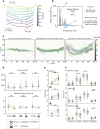Interactions between CNS regulation and serotonergic modulation of crayfish hindgut motility
- PMID: 40535937
- PMCID: PMC12173514
- DOI: 10.1098/rsos.250094
Interactions between CNS regulation and serotonergic modulation of crayfish hindgut motility
Abstract
Motility is a critical function of the gastrointestinal (GI) system governed by neurogenic and myogenic processes. Due to its major role in maintaining homeostasis, overlapping mechanisms have evolved for its adaptive operation including modulation by the central nervous system (CNS), enteric nervous system (ENS) and intrinsic pacemaker cells. Our understanding of the modulatory mechanisms that underlie intestinal motility remains incomplete. Crayfish provide a tractable ex vivo model to study the interplay between CNS and neurochemical regulation of GI motor patterns. Our study investigated the effects of CNS denervation and exogenously applied serotonin (5-HT) on crayfish hindgut motility. Multiscale spatial measurements showed stable motility parameters throughout 90 min of control conditions. Denervation, i.e. separating the gut from the CNS, resulted in a significant decrease in the magnitude and synchrony of hindgut contractions, while preserving the underlying frequency and directional bias of the waves. Subsequent application of 5-HT to the denervated preparation enhanced motility but disrupted spatiotemporal coordination. Treatment with TTX (a sodium channel blocker) had minor impacts on motility metrics, indicating a prominent role of myogenic mechanisms. Our model provides a multiscale analysis framework to dissect CNS and interrelated neurochemistry contributions to GI motor dynamics.
Keywords: gut–brain axis; intestinal motility; invertebrate; optical flow; serotonin.
© 2025 The Authors.
Conflict of interest statement
We declare we have no competing interests.
Figures




![Effects of TTX modulation in hindgut motility metrics (a) Number of spikes recorded during 15 minute time windows [15–30] min, 45−60 min, 105−120 min).](https://cdn.ncbi.nlm.nih.gov/pmc/blobs/2de5/12173514/0f44af91bf55/rsos.250094.f005.gif)
Similar articles
-
Surveillance for Violent Deaths - National Violent Death Reporting System, 50 States, the District of Columbia, and Puerto Rico, 2022.MMWR Surveill Summ. 2025 Jun 12;74(5):1-42. doi: 10.15585/mmwr.ss7405a1. MMWR Surveill Summ. 2025. PMID: 40493548 Free PMC article.
-
Use of β-adrenoreceptor drugs and Parkinson's disease incidence in women from the French E3N cohort study.J Parkinsons Dis. 2025 Jun;15(4):789-804. doi: 10.1177/1877718X251330993. Epub 2025 Apr 29. J Parkinsons Dis. 2025. PMID: 40302366
-
Consumption of the Prebiotic-Rich Chicory Taproot Contrasts the Cognitive and Motivational Consequences of Chronic Corticosterone Exposure and Modulates Gut Microbiota Composition in Mice.Biol Psychiatry Glob Open Sci. 2025 Apr 28;5(4):100520. doi: 10.1016/j.bpsgos.2025.100520. eCollection 2025 Jul. Biol Psychiatry Glob Open Sci. 2025. PMID: 40530341 Free PMC article.
-
Vitamin D: Production, Metabolism, and Mechanism of Action.2025 Jun 15. In: Feingold KR, Ahmed SF, Anawalt B, Blackman MR, Boyce A, Chrousos G, Corpas E, de Herder WW, Dhatariya K, Dungan K, Hofland J, Kalra S, Kaltsas G, Kapoor N, Koch C, Kopp P, Korbonits M, Kovacs CS, Kuohung W, Laferrère B, Levy M, McGee EA, McLachlan R, Muzumdar R, Purnell J, Rey R, Sahay R, Shah AS, Singer F, Sperling MA, Stratakis CA, Trence DL, Wilson DP, editors. Endotext [Internet]. South Dartmouth (MA): MDText.com, Inc.; 2000–. 2025 Jun 15. In: Feingold KR, Ahmed SF, Anawalt B, Blackman MR, Boyce A, Chrousos G, Corpas E, de Herder WW, Dhatariya K, Dungan K, Hofland J, Kalra S, Kaltsas G, Kapoor N, Koch C, Kopp P, Korbonits M, Kovacs CS, Kuohung W, Laferrère B, Levy M, McGee EA, McLachlan R, Muzumdar R, Purnell J, Rey R, Sahay R, Shah AS, Singer F, Sperling MA, Stratakis CA, Trence DL, Wilson DP, editors. Endotext [Internet]. South Dartmouth (MA): MDText.com, Inc.; 2000–. PMID: 25905172 Free Books & Documents. Review.
-
Radiation-induced injury and the gut microbiota: insights from a microbial perspective.Therap Adv Gastroenterol. 2025 Jun 16;18:17562848251347347. doi: 10.1177/17562848251347347. eCollection 2025. Therap Adv Gastroenterol. 2025. PMID: 40535532 Free PMC article. Review.
References
-
- Furness JB, Callaghan BP, Rivera LR, Cho HJ. 2014. The enteric nervous system and gastrointestinal innervation: integrated local and central control. In Advances in experimental medicine and biology microbial endocrinology: the microbiota–gut–brain axis in health and disease, pp. 39–71, vol. 817. New York, NY: Springer. ( 10.1007/978-1-4939-0897-4_3) - DOI - PubMed
Associated data
LinkOut - more resources
Full Text Sources

